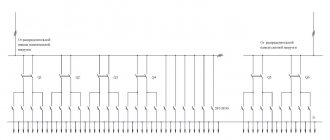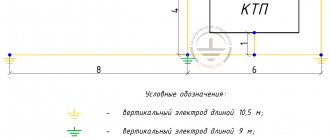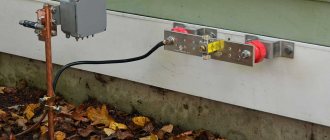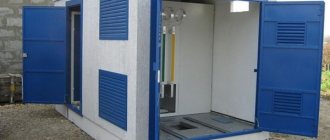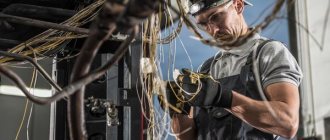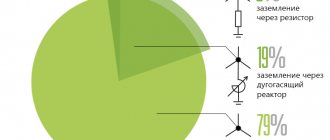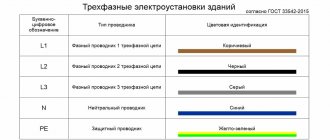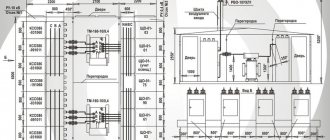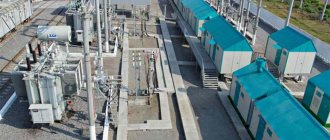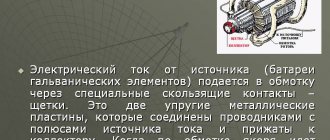Rigid busbar of substations
In Russia, busbars are traditionally carried out using ordinary steel-aluminum wire and fittings designed for overhead power lines are used.
But the tasks and approaches to solving these problems for overhead power lines and substations are different. In particular, modern requirements for the compactness of substations cannot be satisfied with wire busbars. An alternative solution is a rigid busbar, made on the basis of aluminum pipes of a special alloy. The diameters of the pipes are selected based on the current loads of the bus. Until now, the use of such rigid busbars has been limited in Russia due to the lack of a domestic supplier of special busbar supports and special fittings for connecting busbars and their branches from round pipes. Over the past three years, CJSC "Reinforcing and Insulating Plant" (Lytkarino) has been developing and mastering a range of products for rigid busbars of substations. During this time, more than a dozen products were developed and introduced that had not previously been produced in Russia. The combination of specially designed busbar supports, busbars and fittings represents a comprehensive solution for substation busbars. The plant has developed and put into production a large list of not only busbar supports, but also rigid busbar fittings. Modern solutions in high-voltage insulation were used for busbar supports. Busbar supports are made on the basis of polymer rod insulators, taking into account the specific operation of the insulator as part of a busbar support.
Research conducted by specialists has revealed the need to consider a busbar support not just as an insulator and a busbar holder, but as an integrated structure, taking into account their joint work, taking into account the frequency of vibration, short circuit currents, etc. The busbar supports use cast busbar holders made of a special alloy. All this allows us to talk about a complex system of rigid tubular busbars installed on high-voltage equipment in switchgears.
The use of cast prefabricated busbar supports and connecting fittings for rigid busbars provides a number of advantages compared to the welded version. In the new version of the busbar, thanks to the abandonment of welding, it became possible to use a pipe made of 1915T alloy, which has higher electrical conductivity, mechanical strength and corrosion resistance, as a tire. Previously this was impossible due to the poor weldability of this composition.
The improved electrically conductive properties of the new version of the busbar make it possible to increase the throughput and other electrical characteristics of the busbar with the same material consumption. In addition, by changing the geometric dimensions, the loads from climatic influences on the busbar are reduced, and with them the loads on the support insulators and disconnector terminals. The contact surfaces of cast busbar holders have an additional coating that improves electrical contact.
In addition, in places where the surfaces of conductive parts come into contact, the use of electrically conductive lubricant according to EPOS-150, EPOS-250 is provided. Lubricants are specially designed to reduce and stabilize electrical resistance in metal bolted, contact joints of rigid busbar reinforcement and its connection to power equipment. The lubricant can reduce electrical resistance up to a hundred times and stabilize electrical resistance for ten years.
1915T aluminum alloy pipes, which have high strength, corrosion resistance and good weldability, are used as rigid busbars.
Rigid busbars provide quick and high-quality installation, the necessary compensation for linear temperature deformations of tires and minor errors when installing bus supports.
Current compensators guarantee high quality electrical connections. They act as screens, eliminating the possibility of corona discharges and radio interference.
The use of detachable bolted contacts on rigid busbars made it possible to unify sets of rigid busbars and significantly facilitate installation when making various branches with flexible connections, including bundles of wires.
Rigid busbar sets of high factory readiness allow you to reduce the costs of constructing an outdoor switchgear: metal consumption is reduced on average by 10-15 percent, reinforced concrete consumption - by 10-20 percent, structure area - by 10-15 percent, the volume of construction and installation work and labor costs - by 25 percent depending on the electrical connection diagrams of the outdoor switchgear and specific operating conditions in the construction areas.
The rigid busbar is equipped with hollow aluminum pipes class 1915T or an analogue of the E-AlMgSi0.5 series alloy in accordance with DIN EN 573-3, with a damper cable, busbar supports with a breaking load from 12.5 to 20 kN, units for direct fastening of tires to equipment, construction metal structures for supporting insulation, runs of flexible busbars from rigid busbars to equipment and fittings for fastening flexible busbars to equipment. Rigid tires are designed to work at altitudes above sea level up to 1000 meters. Type of climatic modification and placement category - UHL1 according to GOST 15150. Seismic resistance of rigid busbars - up to 9 points on the MSK 64 scale (acceleration in horizontal directions 0.36 g; in vertical direction 0.25 g).
The ZhOS is designed using the block method, that is, depending on the nature of the site and the layout of the 110-500 kV outdoor switchgear, the distance between the axes of the supports in the span for the rigid busbar pipe is determined individually with any cell pitch, which determines the flexibility of the technical solutions included in the project. The layout of substations with ZhOS allows to significantly reduce the area under the switchgear and make the project economically profitable, taking into account the reduction in the cost of materials and the labor intensity of the switchgear construction.
We invite all design organizations to cooperate. We will provide complete equipment catalogs and typical substation diagrams in AutoCAD format. We are ready to develop new types of reinforcement and rigid busbar supports, provide advice, and share experience. We will be glad to have any contacts in this area, which is new for Russia.
TRANSITION TO SINGLE RUN BUSBUS
KAMAZ , MAZ , URAL , IVECO , SCANIA , VOLVO , ITS TRUCKS to save money when replacing tires, suitable only for the option with tires size 425/85 R21 tire type Kama 1260.
There are two main options for switching to a dual-pitch tire:
OPTION 1
Tires and wheels in size 20
Wheel: 10.00x20 Tires: 14.00R20, 395/85R20;
Wheel: 11.25x20 Tires: 16.00R20
- disk 10.00-20 for tires - 14.00-20 for semi-trailers, trawls and KZKT (diskless);
- disk 10.00-20 for tire - 14.00-20 for Iveco, Kamaz 65111, 65115;
- wheel 10.00-20 for tires - 14.00-20 and 395/85 R20 for trailers with zero offset;
- disk 10.00-20 for tire - 14.00-20 for ChMZAP semi-trailers, KZKT trawls;
- wheel 10.00-20 for tire - 16.00-20 for Politrans semi-trailers;
- disk 11.25-20 for tire - 16.00-20 for KrAZ vehicles;
- disk 11.25-20 for the tire - 16.00-20 for MAZ vehicles;
- disk 11.25-20 for the tire - 16.00-20 for MZKT vehicles;
- disk 11.25-20 for tire - 16.00-20 for KamAZ 65222;
- disk 11.25-20 for tire - 16.00-20 for URAL, KrAZ vehicles.
DIFFERENCE
- Low disk cost;
- High cost of tires;
- Large load-carrying capacity of tires, unlike tires 425/85R21 (exception in the TsMK version);
OPTION 2
Tires and wheels in size 21 (533)
Wheel: 12.00x21 (310-533) Tires 425/85R21
Wheel: 17.00x21 (440-533) Tires 1300x530-533
- disk 310-533 for tire - 425/85 R21 (Kama 1260) for KAMAZ 6522, 65225;
- wheel 310-533 for tire - 425/85 R21 (Kama 1260) for foreign-made vehicles: Iveco, Volvo, Scania, Chinese trucks;
- disk 310-533 for tire - 425/85 R21 (Kama 1260) for ET0 trailers;
- disk 440-533 for tire: 21.5/75 R21, 1350x530-533, 1350x550-533, 1300x530-533 for KAMAZ 6522, 65225;
- wheel 440-533 for tire: 21.5/75 R21, 1350x530-533, 1350x550-533, 1300x530-533 for foreign-made vehicles: Iveco, Volvo, Scania, Chinese trucks;
- wheel 440-533 for tire: 21.5/75 R21, 1350x530-533, 1350x550-533, 1300x530-533 for KrAZ 644
DIFFERENCE
- Higher disk cost;
- Low cost combined tire 425/85R21 (Except for the all-metal version);
Selection of circuit breakers
Circuit breakers
Definition:
(
This definition of a circuit breaker is in GOST R 50030.2.)
A circuit breaker (abbreviated as a switch or allegorically an automatic machine) is a mechanical switching device
, allowing you to turn on, pass and turn off electric current under normal conditions; turn on and pass electrical energy for a specified period of time and disconnect a circuit under certain abnormal circuit conditions.
(functionality (application) of circuit breaker)
- Protection function.
The circuit breaker serves to protect electrical networks and various energy consumers from short circuit currents (SC) and overload, as well as from unacceptable voltage drops. To protect against short circuits, an electromagnetic release can be used (in switches from 630A and above, semiconductor or electronic releases). For protection in the overload zone, a thermal release is used (for circuit breakers from 630A or more, semiconductor or electronic releases are used for this purpose). To protect against unacceptable voltage drops, an undervoltage release or a zero-voltage release (optional) is activated.
2. Control function.
Automatic switches allow manual and automatic infrequent operational switching on/off of the circuit. For manual switching, the manufacturer sets the number of operating cycles for a certain time. Often, the higher the amperage of the circuit breaker, the fewer switching operations are allowed. To remotely control the network, the switch must be equipped with an independent release (an additional custom option) or an electromagnetic drive.
3. Role of circuit breaker.
Reusable object protection. The fuse provides only one-time protection (afterwards you need to change the melted insert or replace the fuse itself). Although the switch implies control of the circuit, a switch is usually installed for these purposes. The contact group of the switch tolerates a limited number of switchings, and the cost of the switch is much lower.
Regulatory documents (GOST) according to which low-voltage circuit breakers are produced
Let's list the standards that normalize the production and testing of low-voltage circuit breakers:
GOST R 50345-99 - standard for household circuit breakers (authentic translation of the international standard IEC 60898). GOST R 50030.2-99 - standard for industrial circuit breakers (original Russian translation of IEC 60947.2). GOST 9098-78 is a regulatory document for low-voltage air circuit breakers (the current Union standard).
IEC (English abbreviation IEK) - International Electrotechnical Commission.
Classification of circuit breakers:
Circuit breakers can be classified according to the following characteristics (not a complete list of parameters is given, but a partial one):
1. By application category: A and B. A - non-selective circuit breakers (operation at short-circuit currents occurs without a time delay); B - selective circuit breakers (in short-circuit conditions a short-term specified time delay is provided).
Selectivity:
Overcurrent selectivity is when, when connecting two circuit breakers in series, designed to protect against short circuits, the load-side circuit breaker disconnects the contacts without tripping the second circuit breaker.
The meaning of selectivity:
Switches with rated currents from 1000A are selective; they are installed in front of an industrial complex, they protect further branching circuits and energy consumers. Let's assume that a short circuit occurs in one of the branches of the circuit; when a switch of 1000 A or higher is automatically activated, the entire object will be completely cut off. To prevent this, this machine is given selectivity, that is, a certain period of time is set after which (just in case) it will work. And during this time, a circuit breaker with a lower amperage is triggered, which will turn off the specific branch with the resulting short circuit. In this case, the industrial facility operates without one branch, the selectivity switch does not operate.
For example, designation by category:
— automatic machine of category B — selective circuit breaker (BA 55 41). - category A circuit breaker - non-selective circuit breaker (AE2046).
2. By type of current: direct current, alternating current; for alternating and direct currents. An example of a circuit breaker for alternating current: circuit breaker AE 2056. An example of a circuit breaker for alternating and direct currents: circuit breaker BA 04 36.
Row (line) of rated currents for low-voltage circuit breakers
(numbers - circuit breaker amperage):
What is busbar circuit breakers
Optimal Engineering Solutions in the Electric Power Industry
Stay up to date with news
Main themes
- Technological connection
What are the time-current characteristics of circuit breakers
What are the time-current characteristics of circuit breakers
These letters indicate the instantaneous operation current of the electromagnetic release of the machine. Simply put, the response characteristic of a circuit breaker shows the sensitivity of the circuit breaker - the lowest current at which the circuit breaker will turn off instantly. The machines have several characteristics, the most common of which are: · — B — from 3 to 5xIn; · — C — from 5 to 10хIn; · — D — from 10 to 20хIn. What do the numbers above mean?
EXTRA WIDE TIRES
Standard tractor-trailers or dump trucks usually use two wheels on the drive axles, which are much heavier and more expensive, and also complicate maintenance. To solve this problem, GoodYear introduced “super-wide” Super Single tires that replace twin tires and wheels.
- This reduced the weight significantly;
- Increased carrying capacity;
- Facilitated maintenance;
- Reduced rolling resistance;
- Reduced the load on the units, and hence the interval for their repair;
